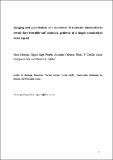Por favor, use este identificador para citar o enlazar a este item:
http://hdl.handle.net/10261/190065COMPARTIR / EXPORTAR:
 SHARE SHARE
 CORE
BASE CORE
BASE
|
|
| Visualizar otros formatos: MARC | Dublin Core | RDF | ORE | MODS | METS | DIDL | DATACITE | |

| Título: | Imaging and Quantitation of a Succession of Transient Intermediates Reveal the Reversible Self-Assembly Pathway of a Simple Icosahedral Virus Capsid |
Autor: | Medrano, María; Fuertes, Miguel Ángel CSIC ORCID; Valbuena, Alejandro CSIC ORCID; Carrillo, Pablo J .P.; Rodríguez-Huete, Alicia CSIC; Mateu, Mauricio G. CSIC ORCID | Fecha de publicación: | 30-nov-2016 | Editor: | American Chemical Society | Citación: | Journal of the American Chemical Society 138: 15385- 15396 (2016) | Resumen: | Understanding the fundamental principles underlying supramolecular self-assembly may facilitate many developments, from novel antivirals to self-organized nanodevices. Icosahedral virus particles constitute paradigms to study self-assembly using a combination of theory and experiment. Unfortunately, assembly pathways of the structurally simplest virus capsids, those more accessible to detailed theoretical studies, have been difficult to study experimentally. We have enabled the in vitro self-assembly under close to physiological conditions of one of the simplest virus particles known, the minute virus of mice (MVM) capsid, and experimentally analyzed its pathways of assembly and disassembly. A combination of electron microscopy and high-resolution atomic force microscopy was used to structurally characterize and quantify a succession of transient assembly and disassembly intermediates. The results provided an experiment-based model for the reversible self-assembly pathway of a most simple (T = 1) icosahedral protein shell. During assembly, trimeric capsid building blocks are sequentially added to the growing capsid, with pentamers of building blocks and incomplete capsids missing one building block as conspicuous intermediates. This study provided experimental verification of many features of self-assembly of a simple T = 1 capsid predicted by molecular dynamics simulations. It also demonstrated atomic force microscopy imaging and automated analysis, in combination with electron microscopy, as a powerful single-particle approach to characterize at high resolution and quantify transient intermediates during supramolecular self-assembly/disassembly reactions. Finally, the efficient in vitro self-assembly achieved for the oncotropic, cell nucleus-targeted MVM capsid may facilitate its development as a drug-encapsidating nanoparticle for anticancer targeted drug delivery. | URI: | http://hdl.handle.net/10261/190065 | DOI: | 10.1021/jacs.6b07663 | Identificadores: | doi: 10.1021/jacs.6b07663 issn: 1520-5126 |
| Aparece en las colecciones: | (CBM) Artículos |
Ficheros en este ítem:
| Fichero | Descripción | Tamaño | Formato | |
|---|---|---|---|---|
| Medranoetal2016.pdf | 1,11 MB | Adobe PDF |  Visualizar/Abrir |
CORE Recommender
SCOPUSTM
Citations
31
checked on 28-abr-2024
WEB OF SCIENCETM
Citations
29
checked on 22-feb-2024
Page view(s)
189
checked on 04-may-2024
Download(s)
279
checked on 04-may-2024
Google ScholarTM
Check
Altmetric
Altmetric
NOTA: Los ítems de Digital.CSIC están protegidos por copyright, con todos los derechos reservados, a menos que se indique lo contrario.
